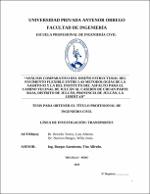Análisis comparativo del diseño estructural del pavimento flexible entre las metodologías de la AASHTO-93 y la del instituto del asfalto para el camino vecinal de Julcán al caserío de chuan parte baja, distrito de Julcán, la libertad

View/
Download
(application/pdf: 14.12Mb)
(application/pdf: 14.12Mb)
Date
2019Author(s)
Briceño Torres, Luis Alberto
Narcizo Burgos, Willy Jesús
Metadata
Show full item recordAbstract
En la actualidad, los caminos vecinales que conectan a los caseríos de los
diferentes Distritos pertenecientes a las provincias del Perú, cumplen un Rol
protagónico en el Desarrollo de los Distritos, permitiendo el transporte de
mercadería de diversa índole, activando la economía y resultando en el desarrollo
social, económico y cultural del Perú.
En la presente tesis se realiza el diseño de la estructura del pavimento flexible de
7.554, kilómetros del Camino Vecinal de Chuan Parte Baja a Julcán, ubicado en el
Departamento de La Libertad, Provincia de Julcán, Distrito de Julcán. Dicho
Camino carece de algún tipo de pavimentación y señalización. La falta de
pavimento en dicho Camino Vecinal, ocasiona retrasos en los transportes y
dificultando el acceso al caserío.
Se diseñará la estructura del pavimento flexible por las metodologías de la
American Association Of State Highway and Transportation Officials (AASHTO) y
la del Instituto del Asfalto (IA), contemplando sus variables de diseño y
procedimientos estipulados en sus guías, para el Camino Vecinal de Julcán al
Caserío de Chuan Parte Baja, Distrito de Julcán, Provincia de Julcán, La Libertad.
Para ello, primero se realizará un levantamiento topográfico del Camino Vecinal en
estudio, posteriormente realizar un estudio de suelos con fines de pavimentación,
el cual será útil para poder definir algunas variables de diseño, luego realizar el
diseño y determinar los espesores de las capas que conforman el pavimento
flexible, posteriormente realizar el Análisis comparativo entre los diseños
realizados para determinar la Alternativa que ofrece mejores resultados en la zona
de estudio.
Se presenta la elaboración del diseño de Estructura de Pavimento Flexible
mediante la metodología de la AASHTO y la del Instituto del Asfalto, en un contexto
con propiedades mecánicas definidas; por tanto, los procesos de los diseños,
pueden ser extrapolados a realidades con similares propiedades mecánicas y
servir así de referencia científica para futuros proyectos. At present, the neighborhood roads that connect the villages of the different
Districts belonging to the provinces of Peru, play a leading role in the Development
of Districts, allowing the transport of merchandise of various kinds, acti vating the
economy and resulting in the social, economic and cultural development of Peru.
In the present thesis the design of the flexible pavement structure of 7.554,
kilometers of the Neighborhood Road of Chuan Parte Baja to Julcán, located in the
Department of La Libertad, Province of Julcán, District of Julcán, is carried out. This
road lacks some type of paving and signaling. The lack of pavement in the Camino
Vecinal, causes delays in transport and difficult access to the hamlet.
The flexible pavement structure will be designed by the methodologies of the
American Association of State Highway and Transportation Officials (AASHTO)
and the Asphalt Institute (IA), contemplating its design variables and procedures
stipulated in its guidelines, for the Roadway of Julcan to the Caserío de Chuan
Lower part, District of Julcán, Province of Julcán, La Libertad. To do this, first a
topographic survey of the roadway under study will be conducted, then perform a
study of soils for paving purposes, which will be useful to define some design
variables, then make the design and determine the thickness of the layers that They
make up the flexible pavement, then perform the comparative analysis between the
designs made to determine the Alternative that offers the best results in the study
area.
The preparation of the Flexible Pavement Structure design is presented through
the methodology of the AASHTO and that of the Asphalt Institute, in a context with
defined mechanical properties; therefore, the processes of the designs can be
extrapolated to realities with similar mechanical properties and serve as a scientific
reference for future projects
Subject
Collections
- Ingeniería Civil [1260]

